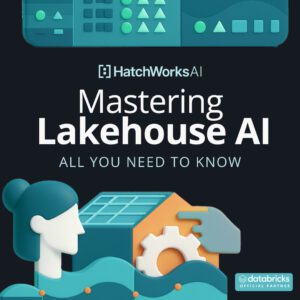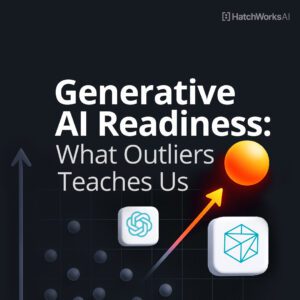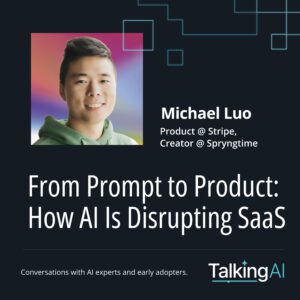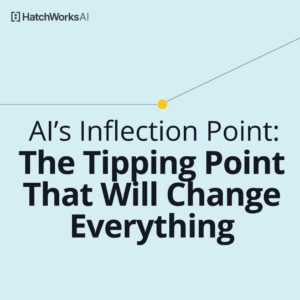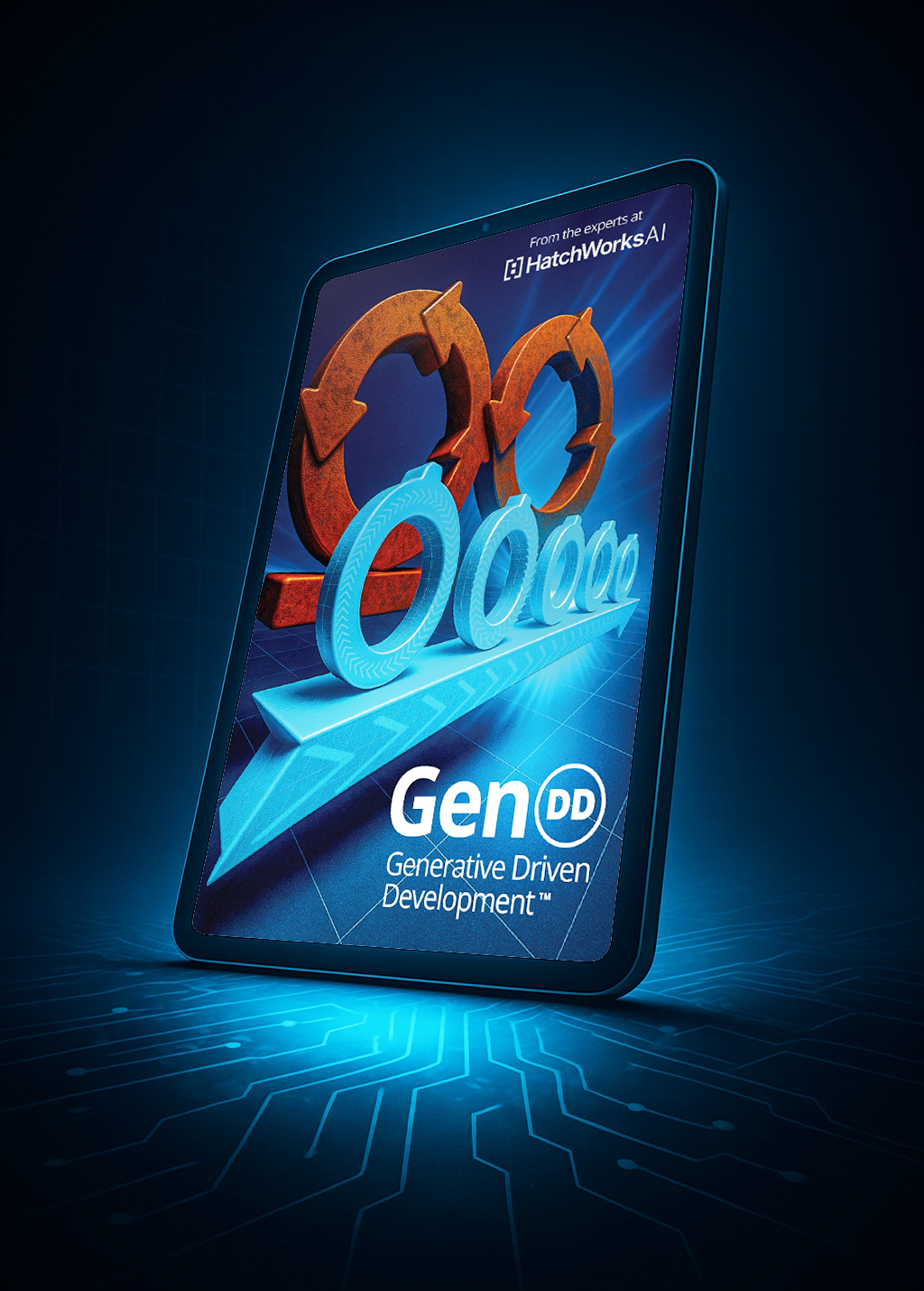It’s not a matter of if generative AI will impact your industry, it’s a matter of how large the impact will be.
McKinsey found that generative AI (Gen AI) features stand to add up to $4.4 trillion to the global economy annually. That is a trillion with a “T”.
This advancement in AI is redefining the way industries operate, unleashing a wave of transformative capabilities that were once the stuff of science fiction.
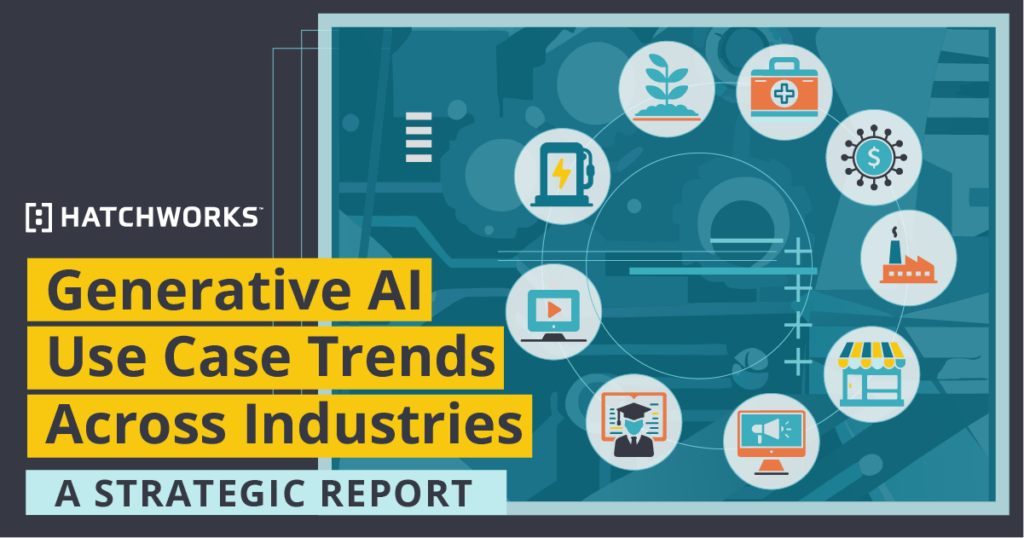
Gen AI, is a subset of machine learning that focuses on teaching computers to generate new content based on existing data. From art and language to problem-solving and creativity, Gen AI is proving to be a game-changer across numerous sectors.
The sheer volume of Generative AI use cases and Gen AI capabilities can be mind-boggling. Whether you’re a healthcare professional seeking more accurate diagnoses, a financial analyst navigating complex markets, a marketer aiming to captivate audiences, or an educator striving for personalized learning experiences, Gen AI has something profound to offer.
Why does understanding the top use cases of Gen AI matter? For businesses, it presents an opportunity for innovation and efficiency, enabling them to stay competitive in a rapidly evolving world. For individuals, it opens doors to new possibilities, augmenting their capabilities and enhancing their quality of life.
This article will serve as your comprehensive guide to the top Generative AI use cases across industries. We will explore how this technology is reshaping the way we work, create, and live.
Here’s what to expect:
- Elevating shopping experiences in Retail and E-commerce using Generative AI
- How Gen AI improves patient outcomes in the Healthcare Industry
- How Gen AI in enhancing client experiences and driving growth in Financial Services
- The ways in which Gen AI is redefining creativity in Marketing and Advertising
- The transformation of operations in Manufacturing through Gen-AI
- The power of personalized learning in Education with the help of Generative AI
- Generative AI’s creative revolution in Entertainment and Content
- How Gen AI is shaping the future of Energy and Sustainability
- Cultivating a sustainable future in Agriculture using Generative AI
- The expanding horizons and future potential of Generative AI
- Conclusion
Retail and E-commerce: Elevating Shopping Experiences with Gen AI Systems
Retail and AI:
Staying ahead of consumer expectations is crucial in retail and E-commerce, and Gen AI may be the key to achieving that. The combination of retail and AI is redefining the shopping experience, making it more personalized, efficient, and engaging.
In this section, we’ll explore how Gen AI is revolutionizing retail and e-commerce, from reducing errors and optimizing inventory management to delivering tailored product recommendations and enabling visual product searches.

Inventory Management:
Effective inventory management is a balancing act between meeting customer demand and minimizing holding costs. Gen AI excels in this domain by analyzing historical sales data, demand forecasts, and market trends. AI algorithms can predict future demand with precision, allowing retailers to optimize their inventory levels.
The real unlock is the ability to query these enormous customer data sets with natural language, making it effortless to draw insights and take action. This not only reduces the risk of overstocking or understocking but also ensures that products are available when customers want them, enhancing overall customer satisfaction.

Shopping Experience:
The shopping experience is about to get a facelift with Gen AI. Walmart is already bringing this technology to its customers by helping shoppers in all stages of the shopping experience from search and discovery to making a purchase. This includes features like a shopping assistant, gen-AI powered search, and an interior design feature helping you virtually design your room

“Generative AI technology is a priority for the company,” said the Walmart spokesperson.
As these AI systems advance, it will enable a truly personalized shopping experience that is interactive, conversational, and multi-dimensional.
Visual Search:
Search is about to get a lot easier. This Gen AI advancement will transform how consumers find products in the digital world. By analyzing images and patterns, AI can identify products similar to those in a user’s photos or descriptions. This enables users to simply snap a picture or describe an item and receive relevant product suggestions.
While Google will certainly be playing at the forefront of this functionality, others are also taking advantage. SnapChat recently announced its rollout of Visual Search. This functionality will allow users to search for products on Amazon simply by simply focusing their camera on a product or barcode and snapping a picture.

Visual search enhances the convenience and speed of finding products, making the shopping process smoother and more enjoyable.
The integration of Gen AI into retail and e-commerce is not just about optimizing business operations; it’s about creating a shopping experience that resonates with customers, fostering loyalty and driving business growth. It’s a testament to the technology’s ability to enhance how we discover and acquire the products we love.
Next, we’ll explore how Gen AI is shaping the landscape of education and e-learning, where personalized learning is paramount.
Healthcare Industry: Improving Patient Outcomes Through Gen AI
Healthcare and AI:
In the healthcare industry, where precision and speed can be a matter of life and death, Gen AI has the potential to be a powerful ally. However, considering some AI use cases do involve human life, proceeding with caution is paramount. The key is to identify AI use cases that have an outsized benefit relative to the potential risk to the patient.

AI-Driven Diagnostics:
One of the most remarkable applications of Gen AI in healthcare is in diagnostics. Traditional diagnostic methods often rely on human interpretation of medical data, such as images and patient histories. This can take a long time. Generative AI, powered by advanced machine learning algorithms, revolutionizes this process.
By analyzing vast datasets of medical records, images, and patient data, artificial intelligence can identify intricate patterns and subtle anomalies that might elude human perception. This not only accelerates the diagnostic timeline but also elevates accuracy to unprecedented levels. Patients benefit from timely and precise diagnoses, which can be crucial in cases where early intervention is essential.
HCA Healthcare is piloting a solution that extracts information from physician-patient conversations to create medical notes. These notes are then transferred to the electronic health record (EHR) helping eliminate manual entry and dictation freeing the doctor up to focus on the patient.
Drug Discovery and Development:
The process of discovering and developing new drugs is notoriously lengthy, complex, and expensive. Gen AI is poised to change this paradigm. By simulating molecular interactions and predicting potential drug candidates, artificial intelligence expedites drug discovery.
This not only accelerates innovation but also reduces the costs associated with research and development. The result is a faster pipeline for bringing life-saving therapies to market. Generative AI is, in essence, a catalyst for groundbreaking medical advancements.
Personalized Treatment Plans:
Every patient is unique, and their healthcare should reflect that individuality. Gen AI has the potential to play an important role in creating personalized treatment plans tailored to each patient’s specific needs.
By analyzing a multitude of data points, including genetic profiles, medical histories, and lifestyle factors, Artificial intelligence can recommend treatment strategies that are not only effective but also minimally invasive. This level of personalization marks a significant shift from one-size-fits-all approaches, ultimately improving patient outcomes and enhancing their quality of life.
The healthcare industry can sometimes be slow to adopt new technologies, but the impact of Gen AI is one that should not be overlooked. It has the potential to reshape the way healthcare professionals approach disease diagnosis, drug development, and patient care. It’s a testament to the remarkable potential of this technology to enhance and even save lives.
Next, we’ll explore how Gen AI is making waves in the financial services sector, where precision and speed are also of utmost importance.
Financial Services: Enhancing Client Experiences and Driving Financial Growth with Gen AI
Financial Services and AI: Revolutionizing Finance with Gen AI
The financial services industry has long been at the forefront of adopting cutting-edge technologies, and Gen AI is no exception. The marriage of financial services and artificial intelligence is reshaping the sector, ushering in an era of unparalleled innovation.
It is also democratizing the field that is typically limited to large hedge funds, algorithmic trading companies, and quant funds that have access to large data models. With the latest introduction to publically available large language models, the playing field is being leveled.
Risk Assessment and Fraud Detection:
In the high-stakes world of finance, risk assessment and fraud detection are paramount. Gen AI, with its ability to analyze vast datasets in real-time, plays a crucial role in safeguarding financial transactions.
AI algorithms can detect unusual patterns and anomalies that may indicate fraudulent activities, providing financial institutions with early warnings to prevent potential breaches. Additionally, Generative AI enhances risk assessment by evaluating complex variables and market trends, enabling more informed decision-making in lending and investment processes.
Algorithmic Trading:
Algorithmic trading, which relies on rapid data analysis and decision-making, is a natural fit for Gen AI. AI-driven algorithms can analyze market conditions, news events, and historical data with lightning speed, executing trades with precision and efficiency.
This not only reduces human errors but also optimizes trading strategies to capitalize on market opportunities. The result is a more efficient and responsive financial market that benefits both institutions and investors.
Customer Service and Chatbots:
Customer service is a critical component of the financial industry, and Gen AI is enhancing customer experiences through AI-powered chatbots and AI agents. These chatbots provide instant, round-the-clock assistance to customers, answering queries, and handling routine tasks such as account inquiries and transaction processing.
Chatbots leverage natural language processing (NLP) to understand and respond to customer queries effectively. This not only improves customer satisfaction but also frees up human agents to focus on more complex tasks, such as personalized financial planning.
The financial services sector’s integration of Gen AI technology is revolutionizing how financial transactions are conducted, risks are assessed, and customer interactions are managed. It’s a testament to the technology’s capacity to streamline operations, enhance security, and provide a more customer-centric approach.
Next, we’ll explore how Gen AI is shaping the world of marketing and advertising, where creativity and precision are paramount.
Marketing and Advertising: Redefining Creativity with Generative AI Tools
Marketing was one of the first industries to quickly adopt and feel the impact of Gen AI, acting as a great use case for other industries. It is turning tasks that typically could take hours even weeks into minutes without sacrificing the creativity required in marketing teams.
This was the one hurdle critics never thought artificial intelligence would cross. But it has with flying colors. In this section, we’ll explore how generative AI tools are revolutionizing marketing and advertising, from content creation and sentiment analysis to targeted advertising and gaining deeper insights into consumer behavior.
Content Generation:
Generating captivating and relevant content is a cornerstone of successful marketing and social media management. Gen AI and the conversational interface are making this easy with tools like ChatGPT and Midjourney to name a few. By analyzing vast datasets of text, images, and video, AI can generate compelling content, including articles, product descriptions, and even advertisements.
This not only saves time but also ensures consistency and relevance, enabling marketing teams to engage their audience more effectively.
Targeted Advertising:
Effective advertising hinges on reaching the right audience with the right message at the right time. Gen AI optimizes this process by leveraging data analytics and machine learning algorithms.
For example, Meta which has a $114 billion a year ad platform just announced generative AI features for advertisers. These features allow for quick generation of subtitle copy and design tweaks between ads allowing quicker and more efficient A/B testing. This is just the beginning as the war for eyeballs will commence between the major digital advertising players.
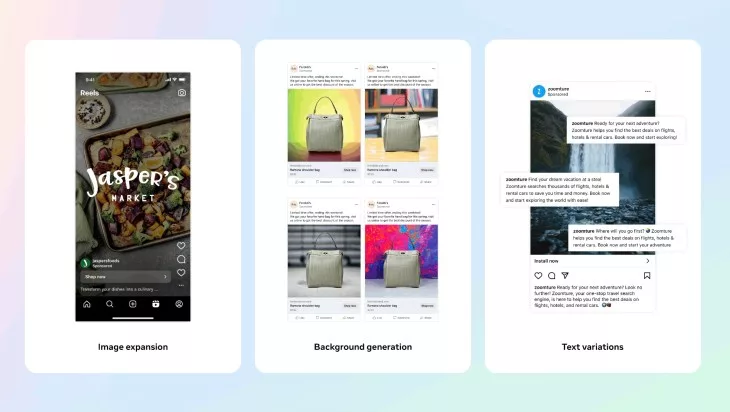
Customer Insights:
Understanding consumer behavior is crucial for crafting winning marketing strategies. Gen AI excels in this area by analyzing vast datasets of consumer interactions, customer inquiries in multiple languages, social media activity, and purchasing habits. AI algorithms can identify patterns and trends, allowing marketers to gain valuable insights into what drives consumer choices.
This data-driven approach empowers marketers to fine-tune their strategies, optimize campaigns, and create more engaging content that resonates with their target audience.
Gen AI’s integration into marketing and advertising is redefining how brands connect with consumers. It’s not just about automation; it’s about elevating creativity and personalization to unprecedented levels.
However, with this innovation comes increased noise as the barrier of entry to create content drops to new lows. The ability to stand out and differentiate will likely get harder. Not easier.
Next, we’ll dive into the manufacturing and industry 4.0 sector, where Gen AI is optimizing operations and driving efficiency.
Manufacturing and Industry 4.0: Transforming Operations with Gen AI
Manufacturing and AI:
Manufacturing has entered a new era with the advent of Industry 4.0, and at its core is the integration of artificial intelligence (AI). Gen AI, in particular, is revolutionizing modern manufacturing by enhancing efficiency, productivity, and innovation. In this section, we’ll delve into how Gen AI technology is reshaping manufacturing and Industry 4.0, from predictive maintenance to product design and supply chain optimization.
Predictive Maintenance:
Deloitte estimates on average, predictive maintenance increases productivity by 25%, reduces breakdown by 70%, and lowers maintenance costs by 25%. Gen AI has the potential to impact these stats to an even greater degree. Traditionally, machinery maintenance was scheduled at regular intervals, often leading to unnecessary downtime, saving time and costs.
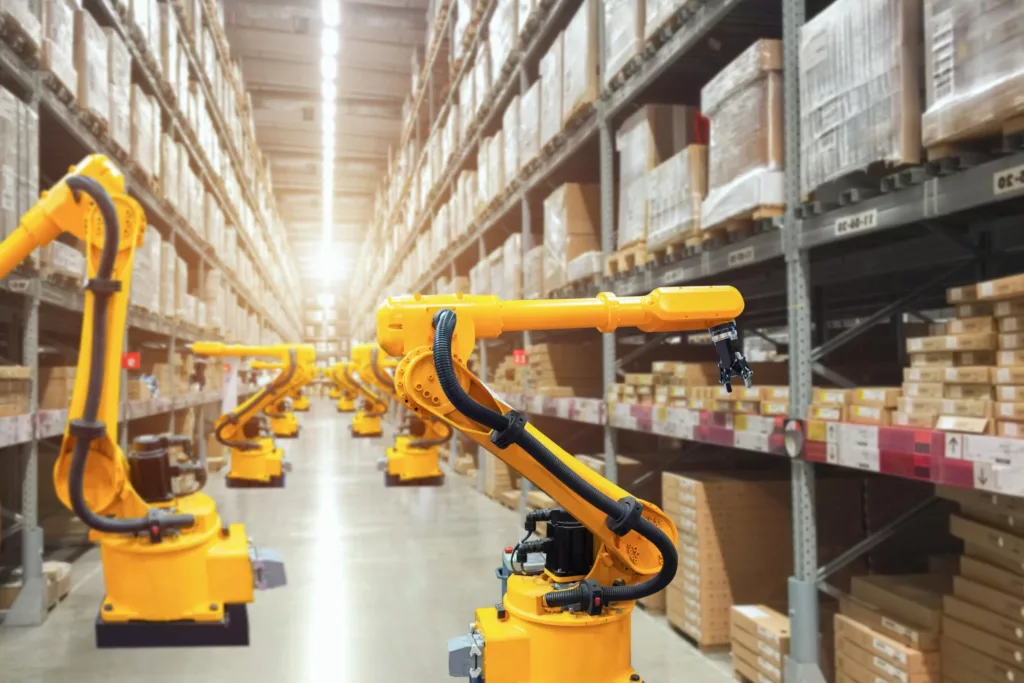
Generative AI changes this by continuously monitoring equipment through sensors and analyzing data in real-time. It can predict when a machine is likely to fail and trigger maintenance just in time, minimizing disruptions and reducing maintenance expenses.
This proactive approach ensures that production lines run smoothly, optimizing overall operational efficiency.
Product Design and Prototyping:
Generative AI plays a pivotal role in product design and prototyping. By analyzing design parameters and constraints, AI can generate and refine design concepts rapidly.
This accelerates the design and development process and also encourages innovation by exploring design possibilities that are overlooked by human designers. Additionally, Generative AI aids in the creation of prototypes by generating 3D models and simulations, facilitating rapid iteration and minimizing costly physical prototypes.
Supply Chain Optimization:
Efficient supply chain management is critical in modern manufacturing. AI algorithms can analyze vast amounts of data from suppliers, logistics, financial reports, and demand forecasts to optimize the entire supply chain. This includes managing inventory levels, minimizing transportation costs, and ensuring timely deliveries.
Supply chain optimization not only reduces operational costs but also enhances responsiveness to market changes, ultimately improving customer satisfaction.
Generative AI’s integration into manufacturing and Industry 4.0 is driving a paradigm shift in how products are designed, produced, and delivered. It’s not just about streamlining processes; it’s about fostering innovation and adaptability, ensuring that manufacturing remains at the forefront of technological advancement.
Next, we’ll explore how Generative AI is reshaping the retail and e-commerce sector, where personalized experiences are key to success.
Education and E-Learning: Personalized Learning Powered by Generative AI
Education and AI:
Generative AI has the potential to change how we learn and educate across the globe. The fusion of education and AI is reshaping learning experiences, making them more personalized, adaptive, and effective. While some are quick to ban tools like ChatGPT, there is an opportunity to enhance the learning experience for both teachers and students.
In this section, we’ll delve into how Generative AI is revolutionizing education and e-learning, from tailoring learning experiences to automating grading and facilitating language learning.
Personalized Learning:
One of the most profound impacts of Generative AI in education is personalized learning. Traditional classrooms often employ a one-size-fits-all approach, which may not cater to the unique needs and pace of individual learners. Generative AI changes this by analyzing student performance data and learning styles to create customized learning paths.
This ensures that each student receives content and assignments tailored to their strengths and weaknesses, optimizing their learning experience and outcomes.
Automated Grading:
Grading and assessment are essential components of education, but they can be time-consuming for educators. Generative AI automates this process, relieving teachers of the burden of manual grading. AI algorithms can evaluate assignments, quizzes, and exams quickly and consistently, providing instant feedback to students. This not only streamlines the grading process but also allows educators to focus on more meaningful aspects of teaching, such as providing mentorship and support.
Language Learning Tools:
Language learning is another area where Generative AI shines. AI-powered language learning apps leverage natural language processing (NLP) to understand and respond to learners’ speech and writing.
These apps provide personalized lessons, practice exercises, and even conversation partners, enhancing language acquisition. Duolingo, a leader in this space, is using a Generative AI solution to make language learning more engaging and interactive. Their new feature Roleplay allows users to practice real-world conversation skills with world characters in the app. The best part is they never get tired of talking to you.

Generative AI makes language learning more engaging and accessible, breaking down language barriers for global learners.
The integration of Generative AI into education and e-learning represents a fundamental shift in how knowledge is imparted and acquired. It’s not just about automating tasks; it’s about enhancing the quality and effectiveness of education, ensuring that learners have the tools and support they need to succeed.
Next, we’ll explore how Generative AI is reshaping the world of entertainment and content creation, where creativity knows no bounds.
Entertainment and Content Creation: A Creative Revolution with Generative AI
Entertainment and AI:
The entertainment industry has always been at the forefront of innovation, and the adoption of generative AI is no different. AI is reshaping how we create, consume, and enjoy content.
In this section, we’ll explore how Generative AI is revolutionizing entertainment and content creation, from generating music, art, and literature to enhancing film and video production and even influencing the world of gaming.
Content Generation:
Generative AI has unlocked the door to limitless creativity. It can now generate text, music, artwork, and even literature with simply a prompt. Music composition algorithms can analyze existing melodies and styles to create original compositions. AI artists can generate paintings, sculptures, and digital art that captivate audiences. Readers can explore neverending AI-generated stories and poems.
This not only pushes the boundaries of human creativity but also democratizes art, making it accessible to a broader audience.
Film and Video Production:
Gen-AI’s impact in film and video will no-doubt be huge. It is even creating a battle between Hollywood writers and AI as Hollywood screenwriters held-out through a 148 day strike.
None the less, AI will have a big impact in the future. AI-powered video editing tools can analyze footage, automatically cut scenes, and even suggest the most emotionally engaging sequences. AI-powered video editing tools can analyze footage, automatically cut scenes, and even suggest the most emotionally engaging sequences.
Special effects, once reserved for big-budget productions, are now within reach through AI-generated visuals. From enhancing visual effects to automating mundane editing tasks, AI elevates the quality and efficiency of film and video production.
A German tech entrepreneur is using AI-powered programs like Midjourney to create the footage, sound effects, and voices for a 70s-inspired sci-fi film.
Gaming:
Generative AI is making a significant impact on the gaming industry, influencing both game development and gameplay. AI-driven algorithms can generate game environments, characters, and even storylines.
This not only accelerates game development but also fosters innovation by creating unique gaming experiences. In gameplay, AI opponents can adapt and learn from players’ actions, providing dynamic and challenging experiences. AI also enhances player experiences through features like real-time translation and helps users with voice recognition.
The integration of Generative AI into entertainment and content creation is pushing the boundaries of what’s possible. It’s not just about automating repetitive tasks; it’s about unlocking new levels of creativity and interactivity, ensuring that entertainment remains a source of wonder and inspiration for audiences worldwide.
Next, we’ll explore how Generative AI is contributing to sustainability and environmental monitoring in the energy sector.
Energy and Sustainability: Transforming the Future with Generative AI
Energy and AI:
The energy sector, a cornerstone of modern life, has the potential to be completely transformed with Generative AI. The combination of energy and AI is redefining how we produce, distribute, and monitor energy, making it more efficient and sustainable.
In this section, we’ll explore how Generative AI is revolutionizing the energy sector, from optimizing energy distribution to advancing renewable energy solutions and monitoring environmental conditions.
Grid Management:
Efficient grid management is critical for ensuring a stable and reliable energy supply. Generative AI plays a pivotal role in this aspect by analyzing vast amounts of data from sensors, weather forecasts, and energy demand patterns. AI algorithms can optimize energy distribution, predict peak demand periods, and even reroute energy flows to prevent outages.
Gridmatic, a company focused on bringing AI to the climate change fight says, “AI is not just useful, but necessary. We use multiple forms of AI, but fundamentally we have built a model of the US electricity grid down to the nodal level. This foundation enables AI-powered forecasting.”
This not only enhances grid reliability but also reduces energy waste and costs, ultimately benefiting both utilities and consumers.
Renewable Energy:
The transition to renewable energy sources is a global imperative, and Generative AI is accelerating this shift. AI algorithms can analyze weather data, solar and wind patterns, and energy consumption trends to optimize the integration of renewable energy sources into the grid.
This ensures that renewable energy is harnessed efficiently and reduces the reliance on fossil fuels, contributing to a more sustainable and eco-friendly energy landscape.
Environmental Monitoring:
Environmental monitoring is crucial for assessing the impact of energy production on the environment. Generative AI aids in this endeavor by analyzing data from remote sensors, satellites, and ground-based measurements. AI can detect changes in air quality, monitor emissions, and assess ecological impacts.
This same data science -driven approach not only enhances environmental stewardship but also enables timely interventions to mitigate environmental damage.
The integration of Generative AI into the energy sector is shaping a more sustainable and efficient future. It’s not just about optimizing energy; it’s about preserving our planet for future generations, ensuring that energy production aligns with environmental responsibility.
In the next section, we’ll explore how Generative AI is revolutionizing the agricultural industry, where precision and sustainability are paramount.
Agriculture: Cultivating a Sustainable Future with Generative AI
Agriculture and AI:
The agricultural industry, essential for feeding the world’s population, can benefit heavily from advancements in generative AI. The combination of agriculture and AI is revolutionizing farming practices, making them more precise, productive, and sustainable.
In this section, we’ll explore how Generative AI is reshaping agriculture, from precision farming to early disease detection and accurate yield predictions.
Precision Agriculture:
Precision is paramount in agriculture, and Generative AI enhances it significantly. Precision agriculture leverages AI-powered tools to analyze data from sensors, satellites, and drones to create detailed maps of fields.
These maps provide insights into soil health, moisture levels, and crop growth, allowing farmers to optimize irrigation, fertilizer application, and planting patterns. The result is higher crop yields, reduced resource consumption, and improved sustainability.

Crop Disease Detection:
Early detection of crop diseases is crucial for minimizing crop loss. Generative AI plays a vital role in this area by analyzing images of crops and leaves to identify signs of diseases, nutrient deficiencies, and pest infestations.
By spotting these issues early, farmers can take proactive measures, such as targeted pesticide application or crop rotation, to safeguard their harvests and minimize environmental impact.
Harvest Prediction:
Accurate yield predictions are essential for efficient farm management and supply chain planning. Generative AI leverages historical data, weather forecasts, and satellite imagery to provide precise yield predictions.
These predictions help farmers make informed decisions about harvesting, storage, and transportation, ultimately reducing food waste and ensuring a stable food supply.
SpaceAG, an agtech startup is doing just this with their algorithm that is trained on 11 varieties of blueberries which recognizes the different phenological stages (flower, green, purple, blue). This recognition and counting give farmers a better prediction of their crop yield allowing for improved quality and quantity.
Integrating Generative AI into agriculture is not just about improving farm operations; it’s about cultivating a sustainable future. It empowers farmers to produce more with fewer resources, minimize environmental impact, and contribute to global food security.
In the final section, we’ll recap the diverse industries where Generative AI is making a significant impact and highlight its potential to shape a more innovative and sustainable world.
Future Potential: Navigating the Expanding Horizons of Generative AI
The Expanding Role of Generative AI:
As we’ve explored, Generative AI is already making waves across various industries, transforming how we work, create, and live. Its role is poised to expand even further as AI technologies continue to evolve.
In the future, we can expect Generative AI to play a more significant role in fields such as healthcare, finance, education, entertainment, energy, and agriculture. The boundaries of what is possible with AI-driven creativity, precision, and efficiency are continually expanding, opening new doors for innovation and progress.
Ethical Considerations:
With great power comes great responsibility, and Generative AI is no exception. As its influence grows, ethical considerations become paramount. Questions about data privacy, bias in AI algorithms, and the potential for misuse need to be addressed.
Responsible AI development and deployment, along with robust ethical frameworks, will be crucial to ensure that Generative AI benefits society without harming it.
On the Talking AI podcast, Jason Schachter – founder of AI Empowerment Group, dug into how you should consider risk when vetting use cases.
Challenges and Future Trends:
While Generative AI holds immense promise, it also faces challenges. These challenges include addressing the “black box” problem in AI, where decisions made by algorithms are not easily explainable, as well as refining AI’s understanding of context and nuance.
In addition to challenges, several emerging trends will shape the future of Generative AI. These include increased automation in various industries, the development of AI-powered creativity tools for artists and content creators, and the continued integration of AI into everyday life through voice assistants, smart devices, and autonomous systems.
Generative AI’s future is bright, but it must be navigated with care, considering ethical implications and addressing challenges. As we continue to find answers to harness the power of these Generative AI use cases, we are on a path toward a more innovative, efficient, and sustainable world, where human creativity and AI-driven precision coexist harmoniously.
See how HatchWorks is leading the way in AI-powered software development.
Our Generative-Driven Development™ leverages cutting-edge AI to optimize your software projects.
Discover the difference on our page.
Embracing the Transformative Power of Generative AI
Gen AI is not just a technology; it’s a catalyst for change. It optimizes daily operations, empowers creativity, and enhances decision-making across numerous sectors. As it continues to evolve, its influence is expanding, promising to reshape even more facets of our lives, from education to agriculture, and energy to sustainability.
The key takeaways are clear:
- GenAI is a disruptive force, revolutionizing industries and redefining standards.
- Personalization, efficiency, and sustainability are central themes across sectors.
- Ethical considerations and responsible AI use must guide its development and deployment.
- Challenges are opportunities for growth, and the future holds exciting trends.
We encourage you, to explore and leverage the power of these Generative AI use cases in your respective fields as you develop your AI strategy. Whether you’re a healthcare professional, financial analyst, marketer, educator, filmmaker, farmer, or anyone else. Embrace it with curiosity, creativity, and responsibility.
